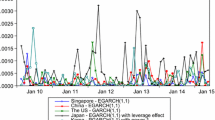Abstract
This paper has analyzed the influence of RMB exchange rate change on our import and export trade for the relationship between our RMB exchange rate and foreign trade. Mechanism, model and empirical research methods of RMB exchange rate change for the competitive advantages of international trade have been set up based on time series autoregressive-moving average model. Empirical analysis results have shown that there is certain necessary connection between RMB appreciation and persistent surplus of China’s balance of trade. The persistent surplus of China’s balance of trade is presented as the persistent deficit of balance of trade in some countries. RMB appreciation can reduce surplus of balance of trade in China and then improve the persistent deficit of balance of trade in some countries.




Similar content being viewed by others
References
Pan, W., Chen, S., Feng, Z.: Automatic clustering of social tag using community detection. Appl. Math. Inf. Sci. 7(2), 675–681 (2013)
Zhang, Y., Li, Q., Welsh, W.J., Moghe, P.V., Uhrich, Kathryn E.: Micellar and structural stability of nanoscale amphiphilic Polymers: implications for Anti-atherosclerotic bioactivity. Biomaterials 84, 230–240 (2016)
Chan, J.W., Zhang, Y., Uhrich, K.E.: Amphiphilic macromolecule self-assembled monolayers suppress smooth muscle cell proliferation. Bioconjug. Chem. 26(7), 1359–1369 (2015)
Abdelhamid, D.S., Zhang, Y., Lewis, D.R., Moghe, P.V., Welsh, W.J., Uhrich, K.E.: Tartaric acid-based amphiphilic macromolecules with ether linkages exhibit enhanced repression of oxidized low density lipoprotein uptake. Biomaterials 53, 32–39 (2015)
Xie, C., Mao, Z., Wang, G.J.: Forecasting RMB exchange rate based on a nonlinear combination model of ARFIMA, SVM, and BPNN. Math. Probl. Eng. 2014(4), 1–10 (2015)
Wang, Y., Li, H.: An empirical research on the transmission mechanism of RMB exchange rate movement-prices. In: International Conference on E -Business and E -Government. IEEE, pp. 1–4 (2011)
Hao, D.: An Empirical Research of the Influence of the Appreciation of RMB Exchange Rate on the Bilateral Trade between China and USA[C]//International Conference on E-Business and E-Government. IEEE Computer Society, pp. 116–119 (2012)
Wei, A: Empirical Research on the Relationship between Technological Structure of Export and RMB Exchange Rate. In: Second International Conference on Business Computing and Global Informatization. IEEE, pp. 357–360 (2012)
Jian, L.: Empirical study on the influence of RMB exchange rate misalignment on China’s export. Front. Econ. China 2(2), 224–236 (2007)
Tian, G., Yang, Y., Dong, B.: The influence of RMB exchange rate fluctuations on the export trade of wooden furniture: The empirical research based on the real effective exchange rate from 2005 to 2009. In: International Conference on E -Business and E -Government. IEEE, pp. 1–4 (2011)
Yun-Su, D.U.: Effect of RMB exchange rate pass-through into china’s import prices: empirical research based on types of enterprises. Finance Trade Res. 5, 014 (2009)
Author information
Authors and Affiliations
Corresponding author
Rights and permissions
About this article
Cite this article
Tian, F. Autoregressive moving average model based relationship identification between exchange rate and export trade. Cluster Comput 22 (Suppl 2), 4971–4977 (2019). https://doi.org/10.1007/s10586-018-2448-9
Received:
Revised:
Accepted:
Published:
Issue Date:
DOI: https://doi.org/10.1007/s10586-018-2448-9




